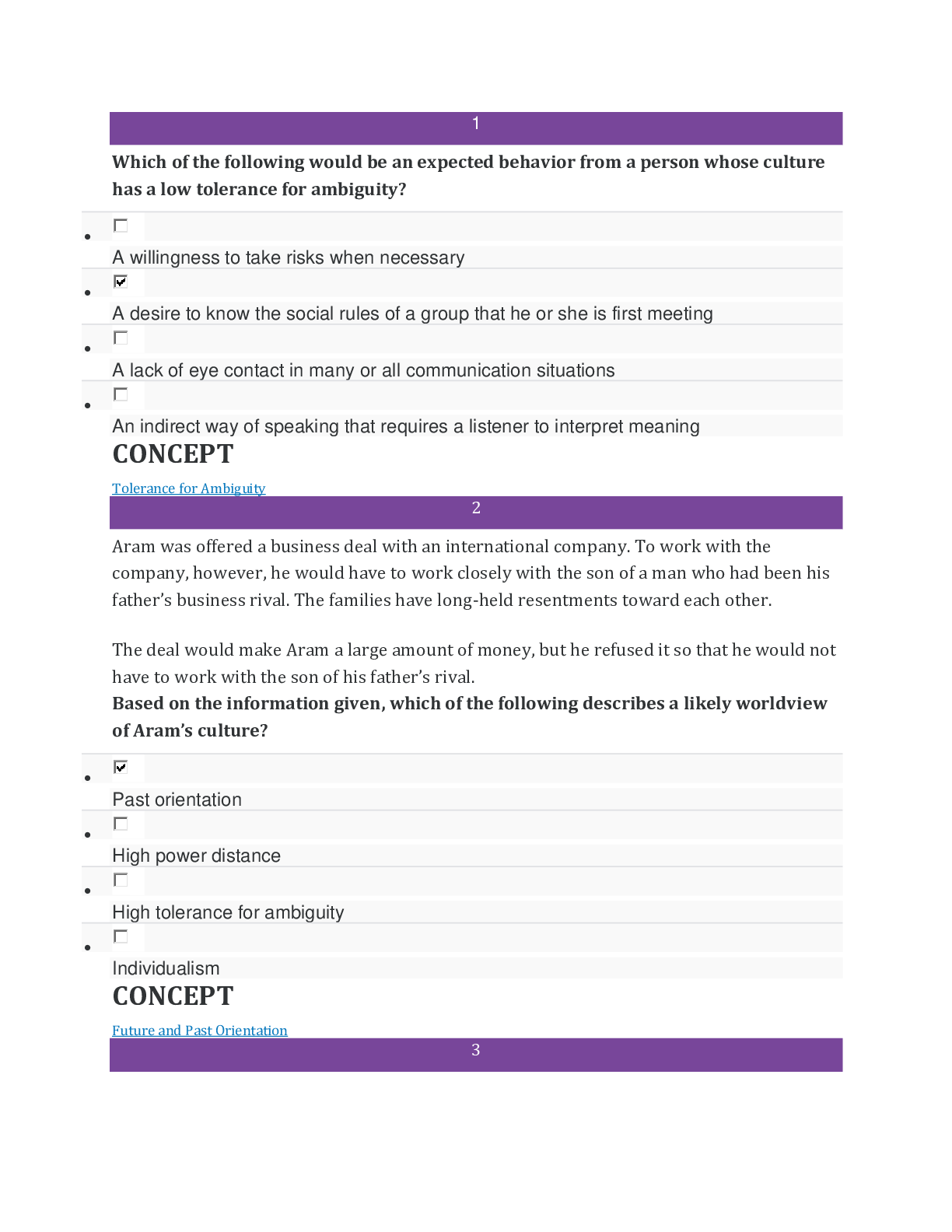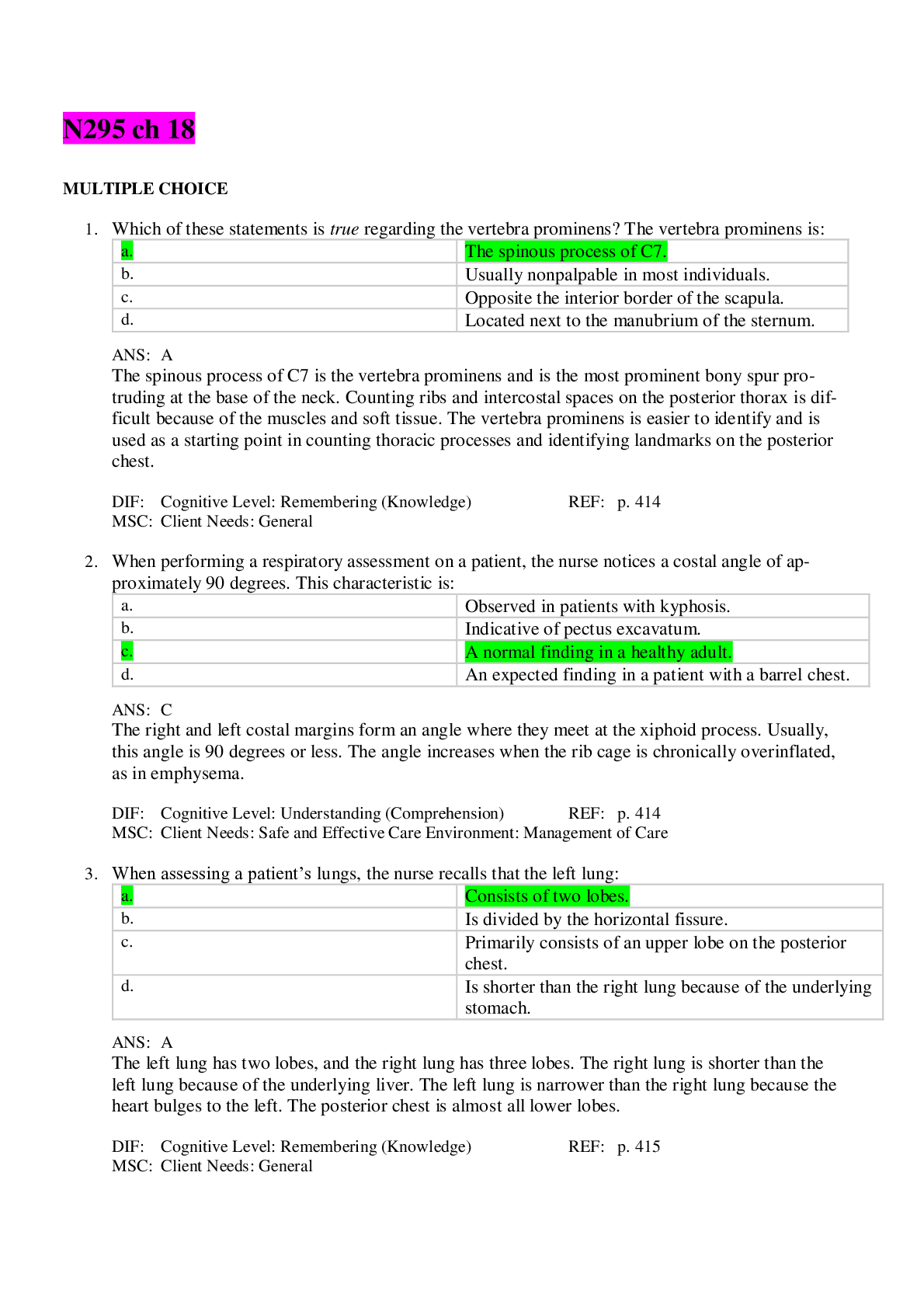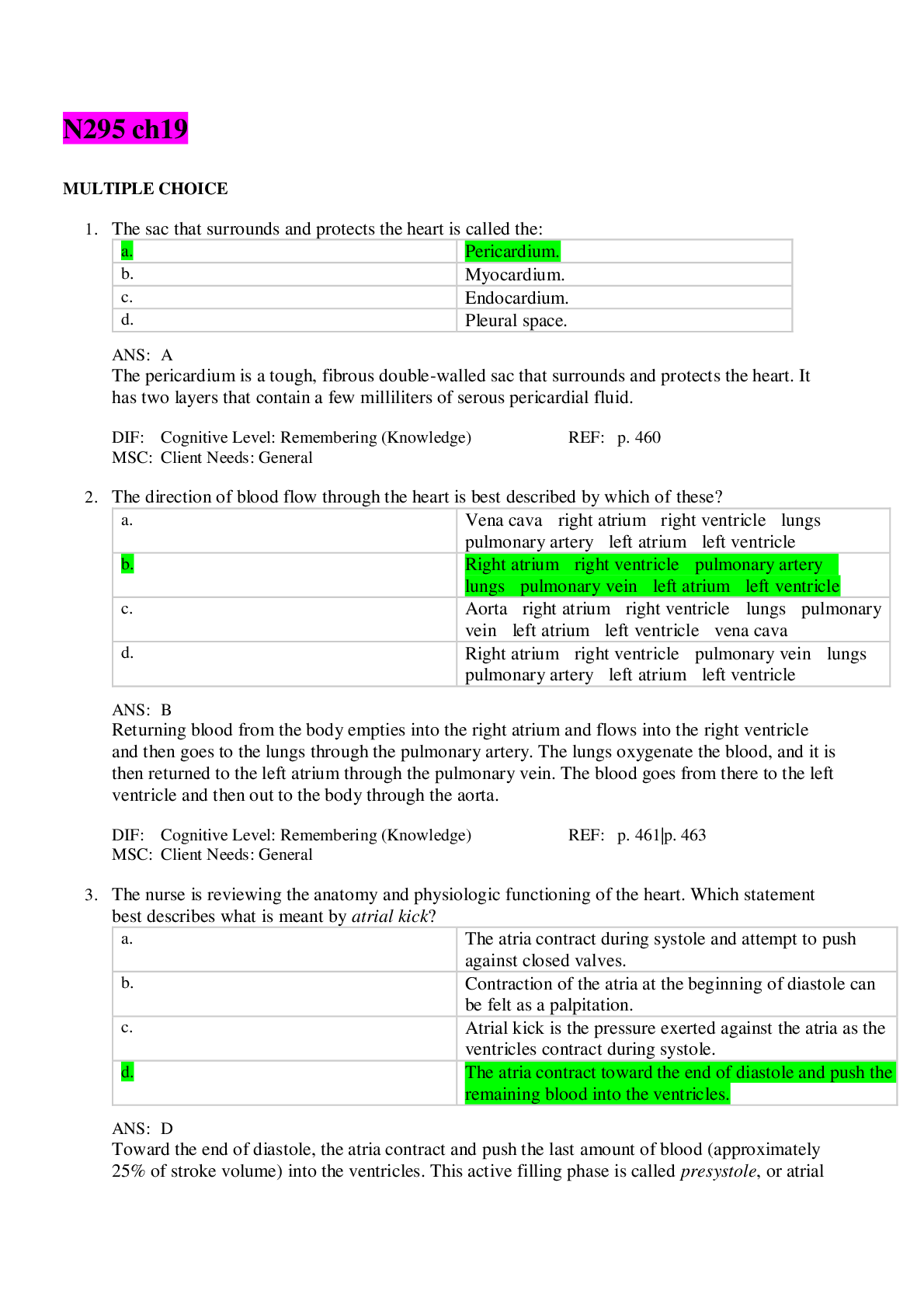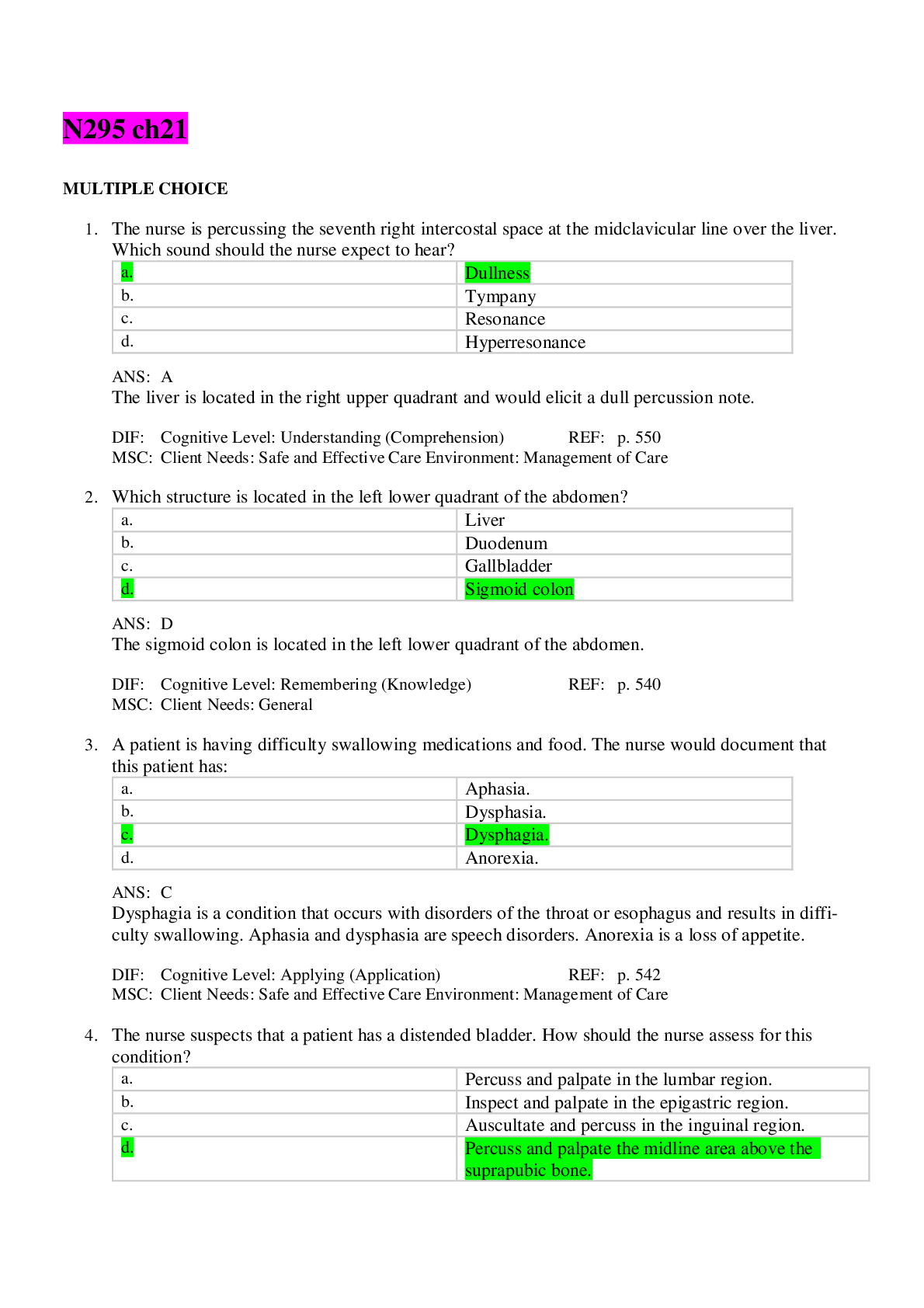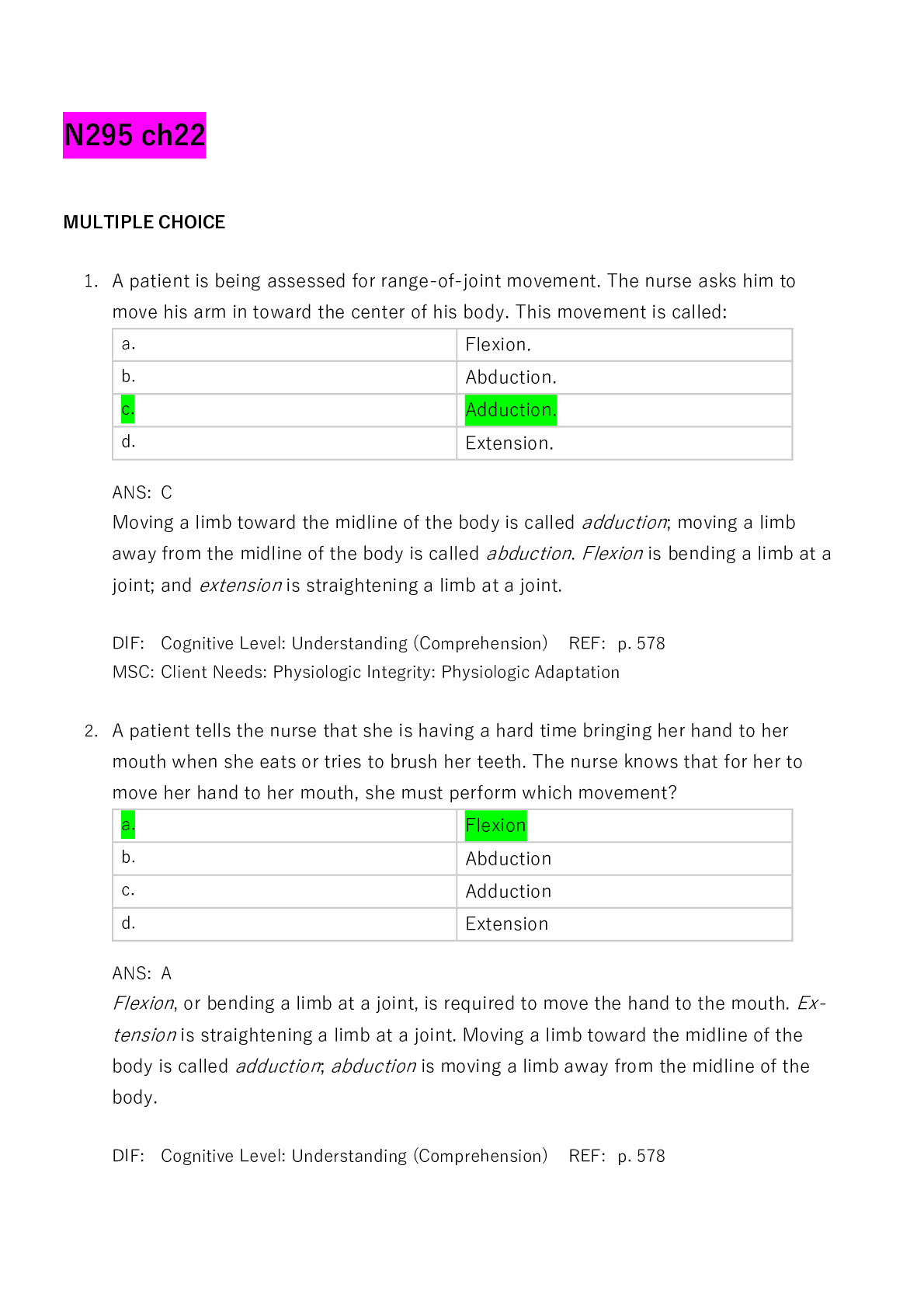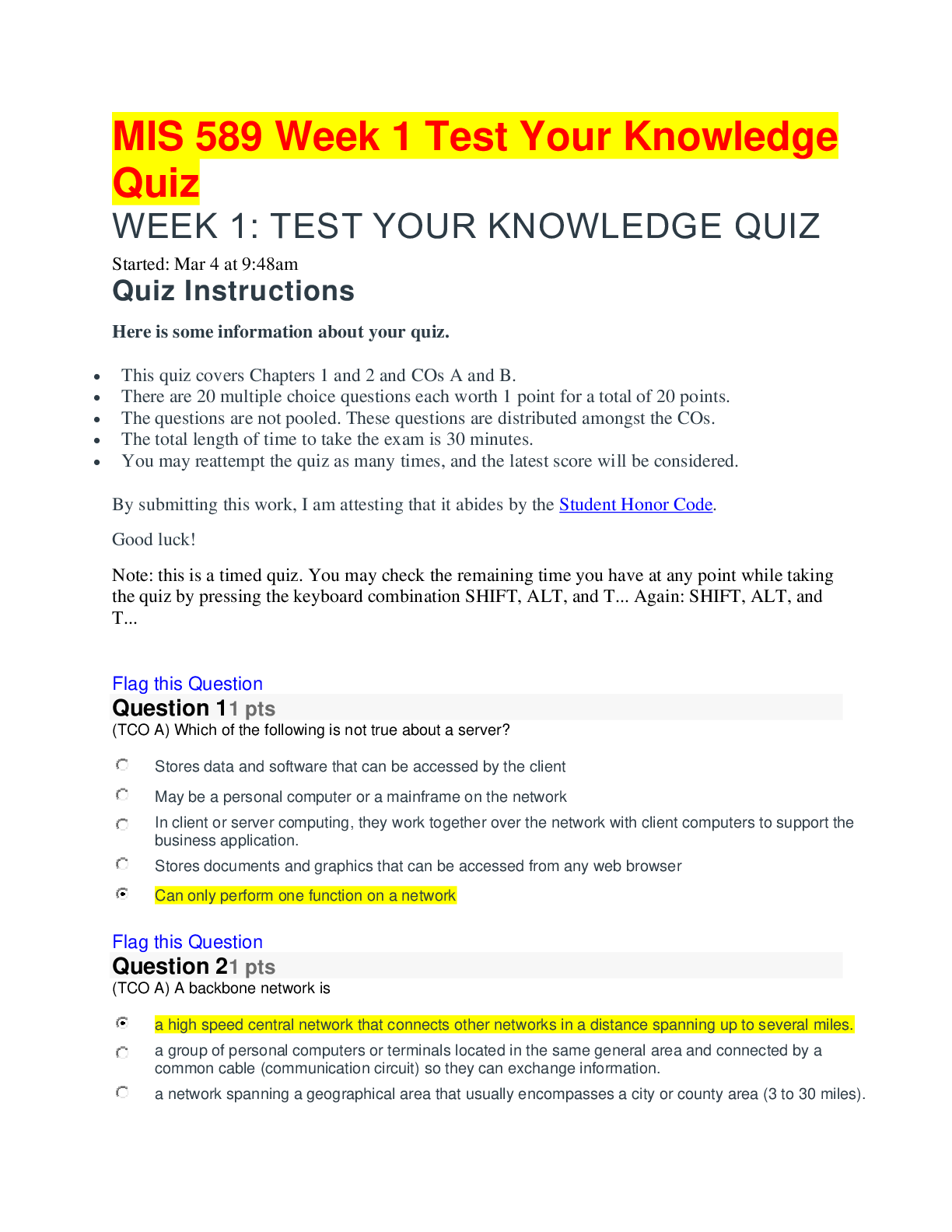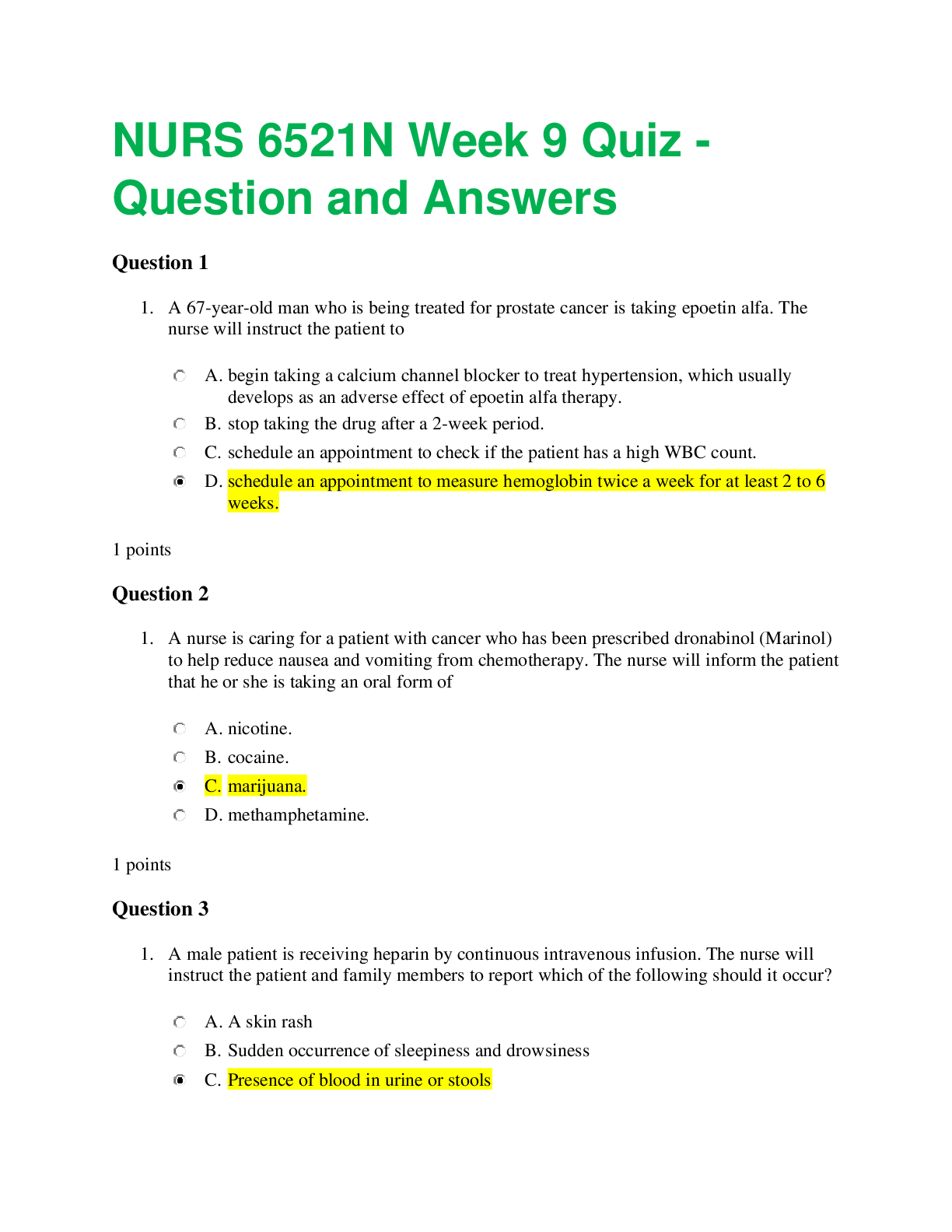Art > EXAM > Chapter 1 Understanding Children's Creative Thought and Expression Questions And Answers (Complete (All)
Chapter 1 Understanding Children's Creative Thought and Expression Questions And Answers (Complete Guide)
Document Content and Description Below
Chapter 1 Understanding Children's Creative Thought and Expression Highlight the correct choice. Number 1 has been completed for you. 1) Children are creative when they: A) answer all questi... ons correctly B) express themselves in inventive, symbolic ways C) recognize words and symbols at an early age D) speak fluently by the age of two E) copy teacher's actions 2) Sternberg's (2008) triarchic theory of intelligence, defines creative thought as the ability to: A) generate ideas B) analyze which ideas are worth pursuing C) implement ideas D) convince others of the value or our ideas 3) Which classical theorist contended that learning is fundamentally cultural and interactive in nature? A) Alfred Adler B) Carl Jung C) Jean Piaget D) Lev Vygotsky E) Abraham Maslow 4) Contemporary experts view creativity as a ________ constructed trait. A) culturally B) cognitively C) personally D) socially E) theoretically 5) Cognitive dimensions of creativity include the following except: A) fluency B) flexibility/adaptability C) curiosity D) originality E) elaboration 6) A mistake commonly made by teachers of young children is: A) being overly influenced by socially desirable behavior B) confusing measures of intelligence with measures of creativity C) being overly influenced by the child's rate of development D) all of these E) none of these 7) Which of the following types of activities stimulate creative thought? A) Coloring in pre-printed pages B) Inventing a robot puppet from recycled materials C) Reading a book about a topic related to history D) Drawing a picture from a teacher's model 8) ________ is a creative trait that refers to the ability to generate many ideas or possible solutions to a problem. A) Originality B) Fluency C) Flexibility D) Elaboration E) Originality and flexibility 9) Characteristics related to creative genius are: A) the ability to become absorbed in an activity B) responsiveness to internal and external stimuli C) lack of inhibition D) all of these E) none of these 10) According to the text, in order for children to feel free to express themselves creatively, they need to acquire a sense of: A) Verbal fluency B) Creativity and originality C) Psychological safety and psychological freedom D) Involvement E) Internal order 11) Which of the following creative thinking traits are often treated as misbehavior or disrespect when exhibited by students from low socioeconomic backgrounds? A) low tolerance for boredom B) excitement and involvement with new designs, music, or ideas C) aggressive and loud use of voice D) high convergent thinking E) A and B ****12) One of the four key points about the way creativity develops is that: A) creativity emerges in isolation and is not dependent upon the environment B) important relationships exist between creativity and culture, especially in the early years C) creative development is mediated by any artifact and is not specific to contextual domains D) both adults and children share in the same culture of creativity 13) All of the following are observable characteristics of children's creative thought processes except: A) formulates hypotheses and conducts trials to test the ideas B) enjoys thinking and working independently C) asks few questions D) are capable of tolerating ambiguity as they explore ideas E) tries to bring order out of chaos by organizing their environment 14) The SCAMPER strategy was originally developed by Osborn (1948/1972) and elaborated on by Barnes (2002). The acronym SCAMPER stands for: A) substitute, combine, adapt, modify, magnify, minify, put to other uses, eliminate, reverse, rearrange B) state, clarify, advance, motivate, participate, estimate, retain, restate C) simplify, calculate, articulate, manage, mediate, perfect, elaborate, record D) seek information, circulate, allow for choices, maintain, produce, emphasize, recognize 15) A preschool teacher wants to support children's creativity and play in her classroom. How can she provide these opportunities for them? A) Designate time in the daily schedule for free play, centers, and other activities that will allow children to follow their interests. B) Take the children to the playground for recess. C) Schedule ample time for large group and circle time activities. D) Purchase pre-made centers and let the children play when they have time. 16) During language arts, a fourth-grade teacher notices students struggling with organizing information related to story elements. What is one effective way the teacher can help students better organize story elements and related details? A) Let the students create ways to organize the information. B) Distribute copies of different graphic organizers and allow students to choose the best one. C) Model the use of appropriate graphic organizers and allow students to build independence in their use. D) Allow the students to discuss the story elements in small groups 17) A teacher wants to incorporate more creativity into a lesson on community helpers for kindergarten children. Which of the following strategies would be an effective way of accomplishing this goal? A) Show students a virtual field trip highlighting community helpers. B) Invite guest speakers who serve as community helpers. C) Have the students research the roles of community helpers. D) Allow the students to dress and re-enact the roles of various community helpers. 18) A new kindergarten teacher asks a veteran teacher how to create a classroom environment that supports creativity. What is the most helpful advice the veteran teacher can offer? A) "Develop centers based on the letters and numbers and include worksheets at each station." B) "Organize your classroom by learning centers and include play, art, music, and drawing." C) "Wait a year until you get a better feel for what you want to do." D) "Set up a classroom library with books students will enjoy." 19) Which of the following activities qualifies as an opportunity for children to be creative in second grade? A) Children are given a pattern for a puppet to color, cut out, and paste. B) A teacher demonstrates how to make a card for Presidents' Day by tracing around silhouettes of past presidents and encourages everyone to produce a card exactly like the one he produced. C) Children work in groups to design sets and simple costumes to use as they perform familiar stories for a kindergarten class. D) Children use computer clip art to make an illustrated book. 20) A father's job requires frequent airline travel and his wife and son, Roberto, often accompany him to the terminal to see him off or pick him up. During a lesson on transportation, the children are discussing a picture of an airplane in a book the teacher is reading to them. Many children are commenting about the size of the plane and their personal experiences riding in one. Roberto immediately starts questions including: "How do they get something so heavy to go up?" "What if there is a big storm and the plane is in the sky?", "What if something breaks?", "What if they run out of gas?" Robert's thinking is an example of: A) Kinesthetic intelligence B) Possibility thinking C) Fantasy D) Intrapersonal intelligence 21) A first-grade teacher presents her lessons on addition concepts in several ways to accommodate to the children's ways of "showing what they know and can do." She includes: a rap/chant about addition, small group practice with math manipulatives, and a cumulative story in which one character is added to the group on each page. Which theorist would most clearly support such practices? A) Alfred Adler B) Jean Piaget C) Howard Gardner D) Lev Vygotsky 22) After reading a story about a frog and a toad, a first grade class began to discuss similarities and differences of toads and frogs. To help the students make a comparison the teacher could use a: A) Venn Diagram B) Sequence Chart C) Concept Map D) Cause and Effect Diagram 23) Creative potential refers to an individual's capacity for behaving in creative ways and includes: A) cognitive abilities B) cognitive processes C) individual dispositions D) all of the above 24) What type of questions stimulate possibility thinking? A) Who B) Where C) What if D) When 25) When children engage in possibility thinking more frequently and are encouraged to experience new and atypical solutions they become: A) more confident in their ability to solve problems B) more adept at possibility thinking C) acquire the habit of thinking creatively D) all of the above 26) Use the following choices to answer the items below. Type the correct choice after each sentence. A. original B. appropriate and relevant C. fluent D. flexible E. all of these 1. ___C____ Creative behavior that results in many new meaningful forms. 2. ___A____ Creative behavior that has a low probability of occurrence. 3. ___B____ Creative behavior that meets the goals of the person who produced it. 4. ___D__ Creative behavior that explores and uses nontraditional approaches to problem solving. 5. ___E____ The components of creative behavior. 27) Use the following choices to answer the items below. Type the correct choice after each sentence. A. imagination B. fantasy C. A and B D. psychological freedom E. psychological safety F. D and E 1. ____A___ The ability to form rich and varied mental images or concepts of people, places, things, and situations which are not present. 2. ____B___ The ability to create mental images or concepts which have little similarity to the real world. 3. ____B___ Explores the impossible or make-believe; the "what-if" situation. 4. ____C___ An intuitive sense of what might be or what something might become. 5. ____C___ Experts believe this peaks during early childhood. 6. ____F___ Carl Rogers' conditions for creative growth. 7. ____E___ The external environment that adults provide for children's creative growth. 8. ____D___ The internal environment, such as the child's self-esteem or confidence. 28) Use the following choices to answer the items below. Type the correct choice after each sentence. A. preparation or brainstorming B. incubation C. illumination D. verification/communication 1. ___B____ The mind begins to formulate and work on a problem. 2. ___C____ Sudden insight, selecting some ideas, or arriving at a solution. 3. ___A____ The application of knowledge, skills and understanding to materials, objects, problems or combinations these things. 4. ___D___ When the outcome of the creative process is shared with others. 5. ___D____ The product of creative thought is tested in terms of usefulness, completeness and correctness. 29) Use the following choices to answer the items below. Type the correct choice after each sentence. A. constructivist B. humanistic theory C. psychoanalytic theory 1. ___B____ The creative person is fully functioning, self-actualized, and courageous. 2. ___C____ Creativity is a way of compensating for perceived physical or psychological inferiority. 3. ___A____ Creativity is a type of problem solving that depends on the child’s thinking processes. 30) For the items below, indicate whether the environment thwarts creativity or supports creativity. Type the correct choice after each sentence. A. This practice tends to thwart creativity. B. This practice tends to support creativity. 1. ____A___ An emphasis on competition 2. ____A___ Lavish praise on children's work 3. ____A___ Inflexible schedules 4. ____B___ Rewarding courage and accepting nonconformist behavior 5. ____B___ Accepting new ideas 6. ____A___ Set strict and limited timelines for project and artifact completion 7. ____B___ Seeking new approaches to problems 8. ____B___ Creating learning communities in classrooms For the next section, choose if the statement is TRUE or FALSE, you can type TRUE or FALSE after each statement 31) Since children are newer to the world, their sensory impressions are particularly keen. TRUE 32) A teacher should encourage rather than praise a child. TRUE 33) According to Gardner, children are not as free in their thinking as adults are. FALSE 34) Imagination and fantasy are components of creativity that generally peak during late years for children. FALSE 35) Giving children printed pictures to color/or cut out is recommended in order to foster their creativity. FALSE 36) By age 5, children's creative thinking is often "stalled." TRUE 37) Divergent thinking means that there is one acceptable answer. FALSE 38) Teachers often associate creativity with economic privilege. TRUE 39) Creative responses and products must be relevant and capable of offering genuine solutions. TRUE 40) Creative thought exists only inside the individual. FALSE 41) High-achieving children, those who do well academically, are the most creative individuals. FALSE 42) Teacher-directed art activities—such as providing the children with cut out shapes and asking them to assemble a picture—stimulate creativity. FALSE 43) Classrooms in which product is emphasized over process are generally more creative environments. FALSE 44) Lev Vygotsky (1933), a Russian theorist, has argued that learning is fundamentally a cognitive activity. FALSE 45) The best way to teach an art lesson is for the teacher to provide young children with patterns to trace or copy. FALSE 46) Generally speaking, teachers who have learned to value the process as well as the product are more likely to encourage creativity among their students. TRUE 47) Behaviors associated with imagination and creativity in young children are often interpreted negatively, discouraged, or even punished. TRUE 48) The most effective way to foster creativity is to constantly praise children's work. FALSE 49) One of the fundamental skills a child learns while developing creativity is that of self-evaluation. TRUE 50) In order for teachers to foster creativity in students, they should provide support and positive feedback for problem finding, not just problem solving. TRUE 51) Activities stimulate creative thought and problem solving when they enable children to engage in teacher-directed work. FALSE 52) Creativity is a mental and social process. TRUE 53) According to social capital theory, social support is necessary to bring creativity to fruition. TRUE [Show More]
Last updated: 1 year ago
Preview 1 out of 9 pages
Instant download

Buy this document to get the full access instantly
Instant Download Access after purchase
Add to cartInstant download
Reviews( 0 )
Document information
Connected school, study & course
About the document
Uploaded On
Feb 22, 2021
Number of pages
9
Written in
Additional information
This document has been written for:
Uploaded
Feb 22, 2021
Downloads
0
Views
94





.png)


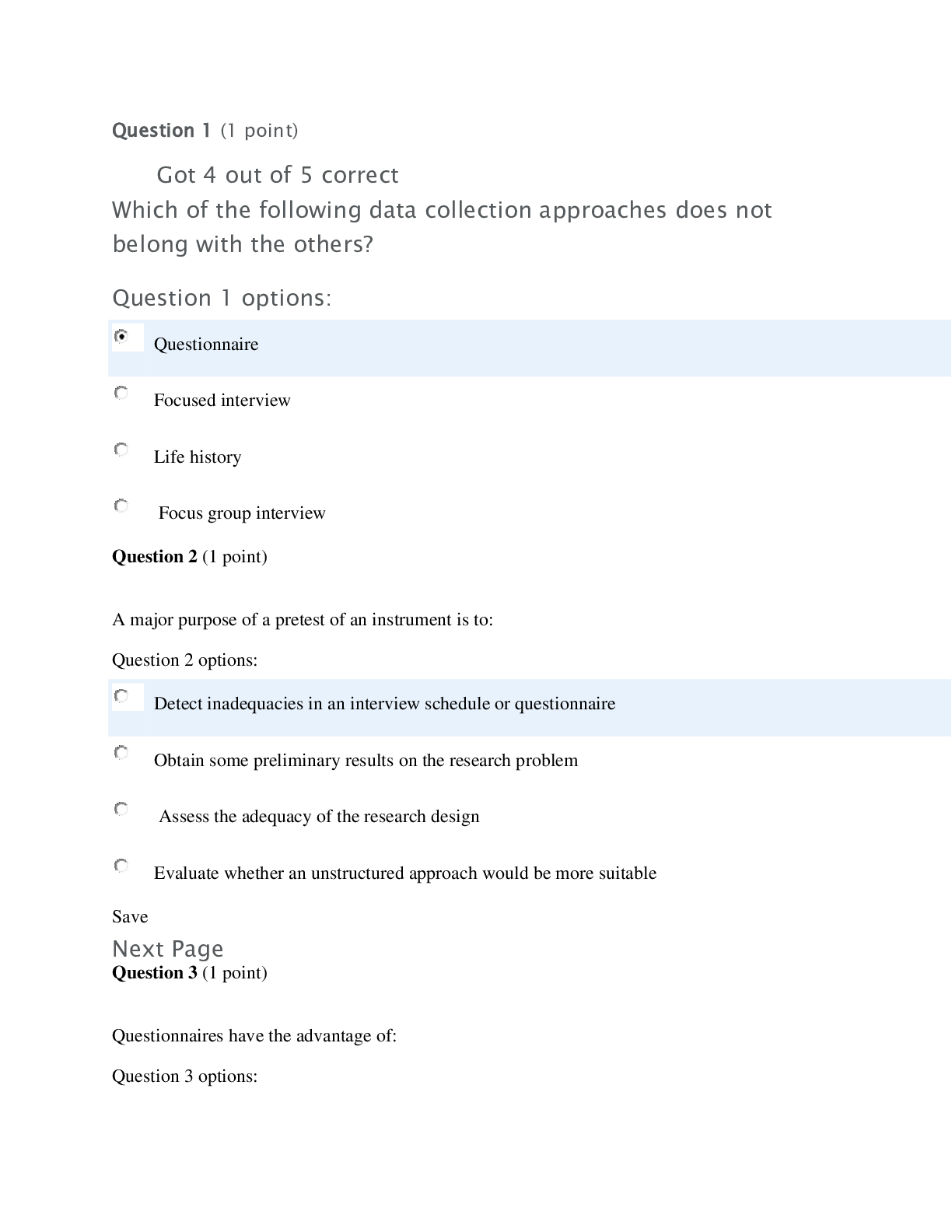


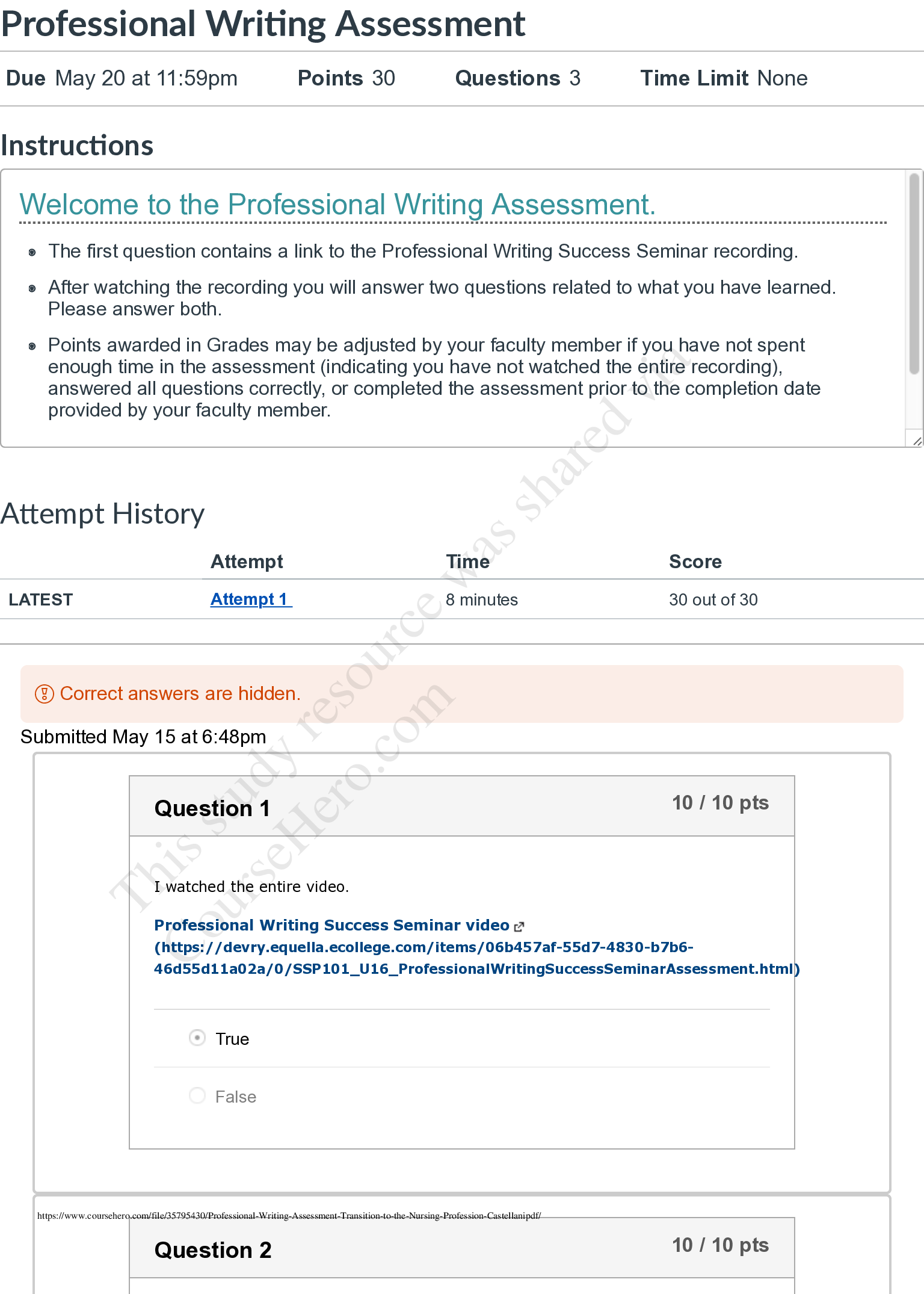
.png)
